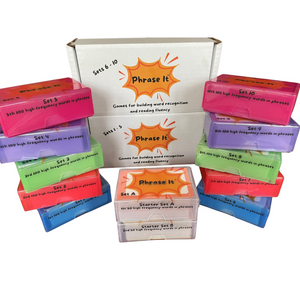FAQ's
how can I help my child read faster?
Step 1: Good reading starts with accuracy. Help your child break down unfamiliar words and then merge the sounds/segments together. Phonics (letter-sound links), onset-rime, word families, analogy to known words, syllable division, prefix/suffix identification, segmenting by meaning (morphology) & letter string/sound linkage (orthography) will all come in handy for phonically regular and less regular ('tricky') words. Then have your child practise reading the words over and over again using flashcards (or games) until recognised at sight (without having to pause to decode/analyse). This builds the 'visual memory' for the word form.
Step 2: Once particular words can be recognised at sight, move on to the next level. Have your child practise reading the word not just on its own but in context. This context can be a phrase or a simple sentence. Reading in the context of other words moves the child on from simply being able to say a word in isolation to being able to read it in a line of text. And this is what reading is all about! Many parents (and teachers) work on the reading of individual words and expect children to be able to recognise these words automatically when seeing them again in text. But many children need a lot more practice with seeing the words in context before they are read at sight.
Step 3: Take advantage of 'repeated reading' strategies, one of the most effective methods for promoting reading fluency. Research has shown that 'repeated reading' is a particularly effective strategy for moving from accuracy to fluency (reading at a good pace with appropriate prosody). Repeated reading means that the child is given 'another go' at reading the same material within a short time frame (not waiting until the next time they might happen to encounter that word). Repeated reading has been shown to be effective at various levels - re-reading words, re-reading phrases and sentences, and re-reading short passages of text.
Step 4: The game Phrase It® helps boost reading accuracy and fluency in 3 ways. It provides a way to practise reading words not just on their own but in a manageable context (phrases). It capitalises on the research-based effectiveness of 'repeated reading' to promote reading fluency. It focuses on the most commonly encountered words, which are read over and over again within a short time frame. And all in a game format!
how can I help my child remember times tables?
So your child has been taught the multiplication tables, but recall seems to be 'hit-or-miss' and not automatic...
Step 1: Take a good look at the individual table facts already known and not known. Determine which ones they know (automatically and by heart), which ones are correct (but take a long time to work out), and which ones need to be worked out from scratch or are getting confused. You can do this by carrying out 'The Big Sort'. See Just in Time(s) Student Workbook for a framework for checking on this.
Step 2: Prioritise the table facts to work on. This means not the table as a whole (e.g. the 8 x table) but the specific ones to work on (e.g. 8 x 6; 8 x 9). You will probably find that they know some of the 8 x table facts by heart already, so there is no need to revisit these. Determine the table facts not yet automatic. The ultimate aim is to be able to recall each of the individual table facts automatically (or with the absolute minimum amount of working out) so they can be accessed quickly and used in wider maths problems.
Step 3: Take advantage of the methods already being taught at school. Perhaps these just need a bit of revisiting, tweaking and reinforcing.
Step 4: Consider trying some different ideas and 'ways in' to complement school-taught methods and see what works best. A variety of methods can be explored to see what is preferred and what sticks. See Just in Time(s) Parent and Teacher Resource for various ideas to try, which might also serve as a springboard for coming up with your own ideas!
Step 5: Practise using the selected method lots and lots of times. Do not be tempted to move on to others that might cause interference or getting the answers muddled. Lock the table fact in memory before moving on to one that could be easily confused with it.
Step 6: Use a Visual Progress Chart so your child can see what they already know and the progress they are making. This is often motivating for learning some of those last few 'sticklers' and is available in the Just in Time(s) Student Workbook.




